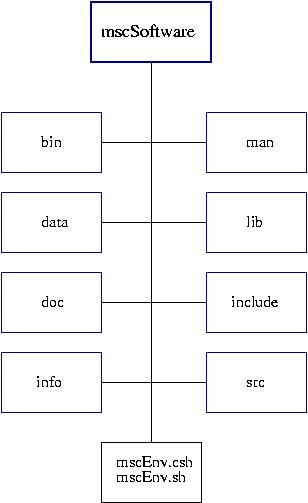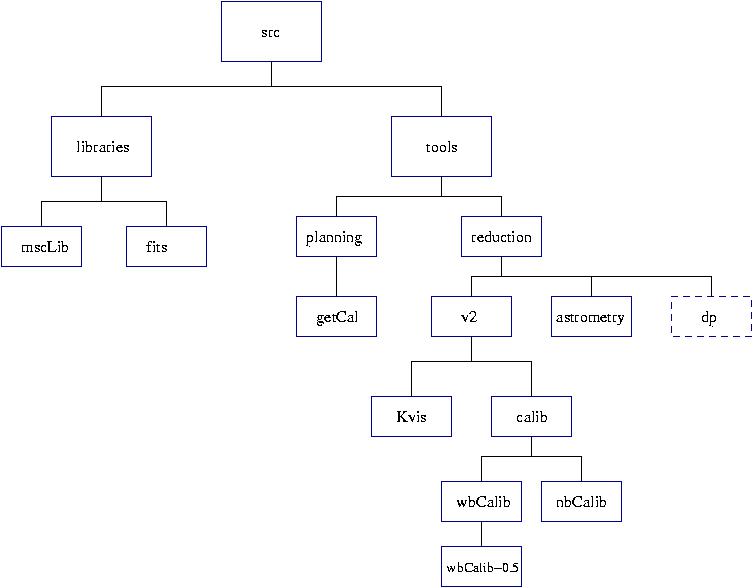
Michelson Science Center Software Tree
A.B. 10/2001, 1/2003
Introduction
This short document describes our model for the software tree
containing distributed Michelson Science Center (MSC) software, and
how to create, modify, and
use it. The scheme here should be taken as our recommendations
on how to package end-user software, but (overstating the obvious)
you should feel free to package the software to accomodate your
system preferences.
The objective of this tree structure is to provide a
unified packaging scheme for the software we distribute to our user
base. Our goals for this packaging scheme are:
- Provide a convenient, consistent structure (recommendation) for
users to download, install, use, and maintain the software in their
local environment.
- Develop this structure that will both allow for multi-user and
single-user installations.
- Develop this structure such that it will equally support users
and/or administrators with and without root access; equivalently users
and/or administrators with and without the desire to install MSC
packages into Unix-standard common areas such as /usr/local/bin and
/usr/local/lib
Top-Level Tree Structure
The root of the Michelson Science Center software tree is the mscSoftware directory --
which can be placed in an arbitrary location in the user's file system.
 As depicted here, inside mscSoftware are the next level of
directories that provide major divisions for software components,
packages, libraries, data, and documentation: bin, data,
doc, include, info, lib, man, and
src. This directory structure emulates Unix standards, and
each subdirectory are described in turn below. Finally there are a
pair of shell scripts mscEnv.csh and mscEnv.sh that
facilitate the setting of common environment variables shared by MSC
packages.
As depicted here, inside mscSoftware are the next level of
directories that provide major divisions for software components,
packages, libraries, data, and documentation: bin, data,
doc, include, info, lib, man, and
src. This directory structure emulates Unix standards, and
each subdirectory are described in turn below. Finally there are a
pair of shell scripts mscEnv.csh and mscEnv.sh that
facilitate the setting of common environment variables shared by MSC
packages.
The bin directory is the container for MSC executables
(e.g. getCal, wbCalib) -- this is the directory that the
user places in his executable search path to use these executables
(see mscEnv.csh below). The bin directory itself is flat with
no internal substructure -- all executables are at the top level in
this directory.
The doc, info, and man directories contain
documentation on MSC packages and software (e.g. this documentation,
man pages).
The data directory contains data resources used by MSC packages
(e.g. the Hipparcos catalog, used by getCal).
The include directory contains header files for
libraries that MSC or third-party packages compile against; the
lib directory contains the corresponding libraries used in
linking executables. Further in lib is the modules
subdirectory, for Perl modules shared among MSC components.
The src directory contains the source for MSC libraries,
scripts, and programs.
mscEnv.csh (mscEnv.sh for sh/bash users) is used to set
a number of common environment variables that facilitate access to Michelson
Science Center software and help different MSC packages work together:
- MSCPATH -- local path specification to mscSoftware
(e.g. /home/bode/mscSoftware)
- MSCBIN -- local path specification to bin
($MSCPATH/bin). Putting MSCBIN in your executable
search path gives you no-muss-no-fuss access to MSC executables.
- MSCDATA -- local path specification to data
($MSCPATH/data)
- MSCINFO -- local path specification to info
($MSCPATH/info)
- MSCMAN -- local path specification to man
($MSCPATH/man)
- MSCLIB -- local path specification to lib
($MSCPATH/lib)
- MSCINCLUDE -- local path specification to include
($MSCPATH/include)
- MSCSRC -- local path specification to src
($MSCPATH/src)
- MSCMODULES -- local path specification to lib/modules
($MSCLIB/modules)
Setting up mscSoftware
In order to assist you with the tedium of setting up a directory
structure by the recipe we describe here, we provide a simple shell
script mkMSCSoftwareTree that
creates an empty tree such as we describe here. [Shift-clicking the
mkMSCSoftwareTree link will
open a save file dialog window in most browsers.]
mkMSCSoftwareTree also creates initial versions of
mscEnv.csh and mscEnv.sh for the user. Sample output from a successful mkMSCSoftwareTree
run is given here, and gives a specific
listing of the various directories created.
Structure within the src directory
As mentioned above, the src directory contains the source for
all installed MSC packages -- scripts, libraries, and programs. When
a user downloads an MSC component (s)he should place it
in the src directory. Strictly speaking, the structure inside
src is completely arbitrary; as long as all the relevant
derived pieces are copied and/or linked into the relevant global
access directories (i.e. bin, include, info, and
lib -- see the installation discussion below), the different
substructures inside of src have no operational implications.
So, the user can arrange src to suit his needs...
That having been said, clearly some substructure in src will
help to keep things organized, and we at the MSC have developed a tree
structure that we find serves our needs. The general flavor of this
structure is illustrated below:

The template tree created by mkMSCSoftwareTree follows these
conventions for src directory structure (see the
mkMSCSoftwareTree output for a complete
listing).
Installing Software in src
Depending on how you like to manage your source distributions, you can
follow (or not) the src structure described above. Either way,
MSC packages dowloaded to your local environment need to be unpacked,
configured, built, and then installed -- typically into directories at
the top-level (e.g. bin, lib, man). This will
usually be done with a configure, make, install sequence:
> configure
> make
> make install
Please consult the build instructions for individual packages for
specific build and install instructions.
 As depicted here, inside mscSoftware are the next level of
directories that provide major divisions for software components,
packages, libraries, data, and documentation: bin, data,
doc, include, info, lib, man, and
src. This directory structure emulates Unix standards, and
each subdirectory are described in turn below. Finally there are a
pair of shell scripts mscEnv.csh and mscEnv.sh that
facilitate the setting of common environment variables shared by MSC
packages.
As depicted here, inside mscSoftware are the next level of
directories that provide major divisions for software components,
packages, libraries, data, and documentation: bin, data,
doc, include, info, lib, man, and
src. This directory structure emulates Unix standards, and
each subdirectory are described in turn below. Finally there are a
pair of shell scripts mscEnv.csh and mscEnv.sh that
facilitate the setting of common environment variables shared by MSC
packages.

